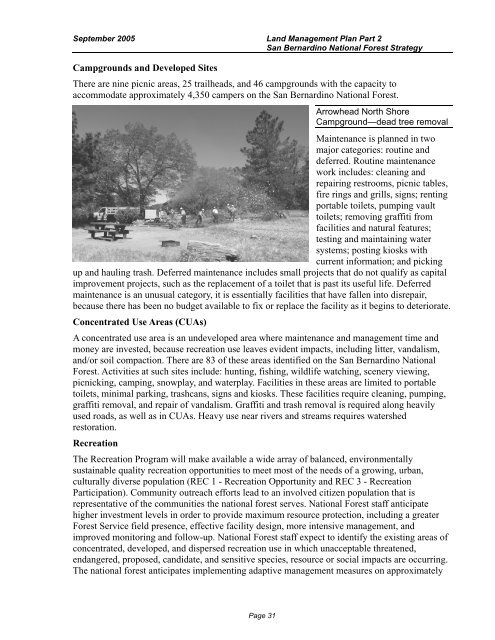San Bernardino National Forest Land Management Plan - Part 2
San Bernardino National Forest Land Management Plan - Part 2
San Bernardino National Forest Land Management Plan - Part 2
You also want an ePaper? Increase the reach of your titles
YUMPU automatically turns print PDFs into web optimized ePapers that Google loves.
September 2005 <strong>Land</strong> <strong>Management</strong> <strong>Plan</strong> <strong>Part</strong> 2<br />
<strong>San</strong> <strong>Bernardino</strong> <strong>National</strong> <strong>Forest</strong> Strategy<br />
Campgrounds and Developed Sites<br />
There are nine picnic areas, 25 trailheads, and 46 campgrounds with the capacity to<br />
accommodate approximately 4,350 campers on the <strong>San</strong> <strong>Bernardino</strong> <strong>National</strong> <strong>Forest</strong>.<br />
Arrowhead North Shore<br />
Campground—dead tree removal<br />
Maintenance is planned in two<br />
major categories: routine and<br />
deferred. Routine maintenance<br />
work includes: cleaning and<br />
repairing restrooms, picnic tables,<br />
fire rings and grills, signs; renting<br />
portable toilets, pumping vault<br />
toilets; removing graffiti from<br />
facilities and natural features;<br />
testing and maintaining water<br />
systems; posting kiosks with<br />
current information; and picking<br />
up and hauling trash. Deferred maintenance includes small projects that do not qualify as capital<br />
improvement projects, such as the replacement of a toilet that is past its useful life. Deferred<br />
maintenance is an unusual category, it is essentially facilities that have fallen into disrepair,<br />
because there has been no budget available to fix or replace the facility as it begins to deteriorate.<br />
Concentrated Use Areas (CUAs)<br />
A concentrated use area is an undeveloped area where maintenance and management time and<br />
money are invested, because recreation use leaves evident impacts, including litter, vandalism,<br />
and/or soil compaction. There are 83 of these areas identified on the <strong>San</strong> <strong>Bernardino</strong> <strong>National</strong><br />
<strong>Forest</strong>. Activities at such sites include: hunting, fishing, wildlife watching, scenery viewing,<br />
picnicking, camping, snowplay, and waterplay. Facilities in these areas are limited to portable<br />
toilets, minimal parking, trashcans, signs and kiosks. These facilities require cleaning, pumping,<br />
graffiti removal, and repair of vandalism. Graffiti and trash removal is required along heavily<br />
used roads, as well as in CUAs. Heavy use near rivers and streams requires watershed<br />
restoration.<br />
Recreation<br />
The Recreation Program will make available a wide array of balanced, environmentally<br />
sustainable quality recreation opportunities to meet most of the needs of a growing, urban,<br />
culturally diverse population (REC 1 - Recreation Opportunity and REC 3 - Recreation<br />
<strong>Part</strong>icipation). Community outreach efforts lead to an involved citizen population that is<br />
representative of the communities the national forest serves. <strong>National</strong> <strong>Forest</strong> staff anticipate<br />
higher investment levels in order to provide maximum resource protection, including a greater<br />
<strong>Forest</strong> Service field presence, effective facility design, more intensive management, and<br />
improved monitoring and follow-up. <strong>National</strong> <strong>Forest</strong> staff expect to identify the existing areas of<br />
concentrated, developed, and dispersed recreation use in which unacceptable threatened,<br />
endangered, proposed, candidate, and sensitive species, resource or social impacts are occurring.<br />
The national forest anticipates implementing adaptive management measures on approximately<br />
Page 31
















